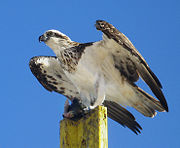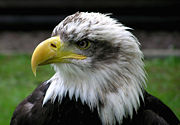Bird of prey
2008/9 Schools Wikipedia Selection. Related subjects: Birds
| Birds of Prey | ||||||
|---|---|---|---|---|---|---|
 Australasian Osprey
|
||||||
| Scientific classification | ||||||
|
||||||
| Orders | ||||||
|
A Bird of Prey, or Raptor, is a bird that hunts for food primarily on the wing, using its keen senses, especially vision; the talons and beaks tend to be relatively large, powerful and adapted for tearing and/or piercing flesh.
Diurnal birds of prey traditionally belong to the order Falconiformes:
The New World vultures are usually also regarded as birds of prey, although they may not be closely related to the other groups.
Nocturnal birds of prey - the owls - are not classified with either of the aforementioned taxa but are instead considered to be members of two extant families - the Strigidae (typical owls) and the Tytonidae (barn and bay owls) - of the order Strigiformes.
The observation that otherwise unrelated bird groups may perform similar ecological roles and bear striking morphological similarities to one another is explained largely by the idea of convergent evolution.
Raptor names
- Eagles tend to be large birds with long, broad wings and massive feet. Booted eagles have legs and feet feathered to the toes and build very large stick nests.
- Kites have long wings and relatively weak legs. They spend much of their time soaring. They will take live animal prey but mostly feed on insects or even carrion.
- The true hawks are medium-sized birds of prey that usually belong to the genus Accipiter (see below). They are mainly woodland birds that hunt by sudden dashes from a concealed perch. They usually have long tails for tight steering.
- Buzzards are raptors with robust bodies and broad wings, or, alternatively, any bird of the genus Buteo (also commonly known as Hawks in North America).
- Harriers are large, slender hawk-like birds with long tails and long thin legs. Most hunt small vertebrates with a combination of keen eyesight and hearing, gliding and circling low over grasslands and marshes on their long broad wings.
- Vultures are carrion-eating raptors of two distinct biological families, each occurring in only the Eastern Hemisphere (Accipitridae) or the Western (Cathartidae). Members of both groups have heads either partly or fully denuded of feathers.
- Falcons are small to medium sized birds of prey with long pointed wings. Unlike most other raptors, they belong to the Falconidae rather than the Accipitridae. Many are particularly swift flyers. Instead of building their own nests, falcons appropriate old nests of other birds but sometimes they lay their eggs on cliff ledges or in tree hollows. Caracaras are a distinct subgroup of the Falconidae unique to the New World, and most common in the Neotropics - broad wings, naked faces and the appetites of a generalist suggest some level of convergence with either the Buteos or the vulturine birds, or both.
- Owls are variable-sized nocturnal hunting birds. They fly soundlessly and have very acute senses of hearing and sight.
